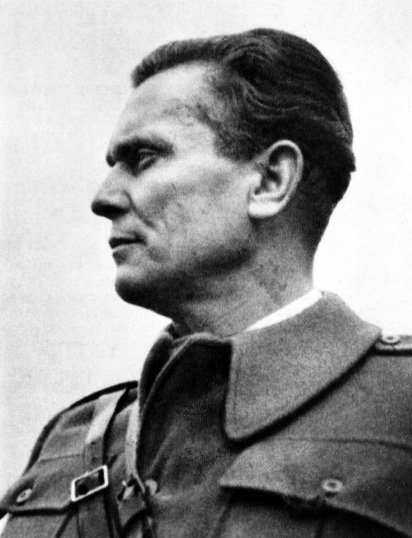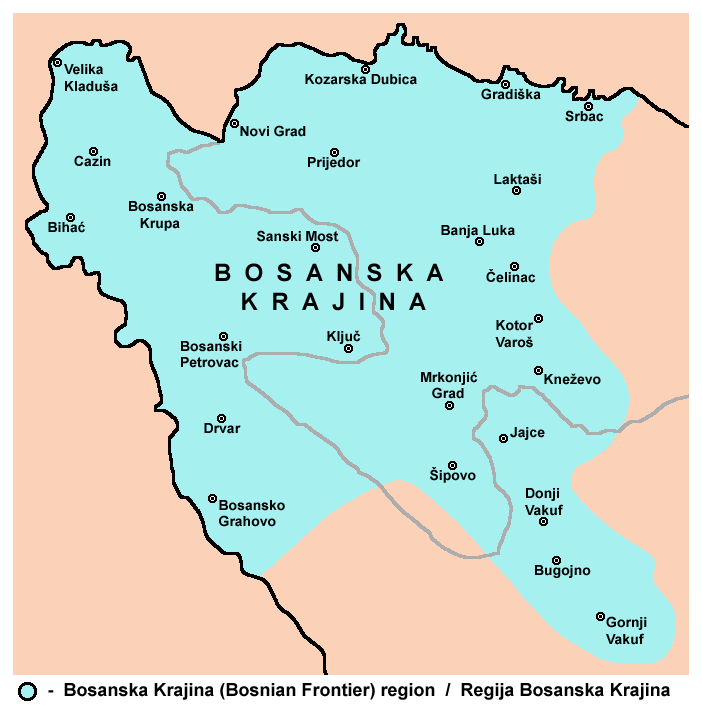|
Nurija Pozderac
Nurija Pozderac (15 January 1892 – 12 June 1943) was a Bosnian teacher, politician, member of the Yugoslav Muslim Organization, and local liberation leader during World War II, participating in the National Yugoslav Liberation Struggle. He served as Vice President of the Executive Board of the Anti-Fascist Council for the National Liberation of Yugoslavia. His nephews Hakija and Hamdija were influential communist politicians during the era of Yugoslavia. Early life Pozderac was one of 11 children—seven sons and four daughters—born to Bashi-bazouk Agha Murat Pozderac (1862–1930), the last leader of Cazin, Bosnia and Herzegovina during Ottoman rule. His father had three wives, a common practice in 19th century Bosnia. His six brothers were Mujaga, Mehmed, Muhamed, Smail, Ahmet, Hasan; his four sisters were Semka, Derviša, Šefika, and Zulejha. Politics Nurija was a teacher before moving into politics in the 1930s. His first serious political engagement cam ... [...More Info...] [...Related Items...] OR: [Wikipedia] [Google] [Baidu] |
Anti-Fascist Council Of National Liberation Of Yugoslavia
The Anti-Fascist Council for the National Liberation of Yugoslavia,, mk, Антифашистичко собрание за народно ослободување на Југославија commonly abbreviated as the AVNOJ, was a deliberative and legislative body that was established in Bihać, Yugoslavia, in November 1942. It was established by Josip Broz Tito, the leader of the Yugoslav Partisans, an armed resistance movement led by the Communist Party of Yugoslavia to resist the Axis occupation of the country during World War II. The AVNOJ reconvened in Jajce in 1943 and in Belgrade in 1945, shortly after the war in Europe ended. Between the sessions, it operated through its presidency, its executive council, and the National Committee for the Liberation of Yugoslavia. The committee was granted authority normally wielded by cabinets. While Tito presided over the committee, the AVNOJ sessions and its presidency were chaired by Ivan Ribar. The second session of the AVNOJ ... [...More Info...] [...Related Items...] OR: [Wikipedia] [Google] [Baidu] |
Agha (Ottoman Empire)
Agha ( tr, ağa; ota, آغا; fa, آقا, āghā; "chief, master, lord") is an honorific title for a civilian or officer, or often part of such title. In the Ottoman times, some court functionaries and leaders of organizations like bazaar or the janissary units were entitled to the ''agha'' title. In rural communities, this term is used for people who own considerable lands and are influential in their community. Regardless of a rural community, this title is also used for any male that is influential or respected. Etymology The word ''agha'' entered English from Turkish, and the Turkish word comes from the Old Turkic language, Old Turkic ''aqa'', meaning "elder brother". It is an equivalent of Mongolian language, Mongolian word ''aqa'' or ''aka''. Other uses "Agha" is nowadays used as a common Persian language, Persian honorific title for men, the equivalent of "mister" in English language, English.Khani, S., and R. Yousefi. "The study of address terms and their translatio ... [...More Info...] [...Related Items...] OR: [Wikipedia] [Google] [Baidu] |
Israel
Israel (; he, יִשְׂרָאֵל, ; ar, إِسْرَائِيل, ), officially the State of Israel ( he, מְדִינַת יִשְׂרָאֵל, label=none, translit=Medīnat Yīsrāʾēl; ), is a country in Western Asia. It is situated on the southeastern shore of the Mediterranean Sea and the northern shore of the Red Sea, and shares borders with Lebanon to the north, Syria to the northeast, Jordan to the east, and Egypt to the southwest. Israel also is bordered by the Palestinian territories of the West Bank and the Gaza Strip to the east and west, respectively. Tel Aviv is the economic and technological center of the country, while its seat of government is in its proclaimed capital of Jerusalem, although Israeli sovereignty over East Jerusalem is unrecognized internationally. The land held by present-day Israel witnessed some of the earliest human occupations outside Africa and was among the earliest known sites of agriculture. It was inhabited by the Canaanites ... [...More Info...] [...Related Items...] OR: [Wikipedia] [Google] [Baidu] |
Perućica
Perućica ( sr-cyrl, Перућица) is one of the last remaining primeval forests in Europe. It is located in Bosnia and Herzegovina, near the border with Montenegro. It is part of the Sutjeska National Park.Sutjeska '''' 
[...More Info...] [...Related Items...] OR: [Wikipedia] [Google] [Baidu] |
Vučevo Plateau
Vučevo ( sr-cyrl, Вучево) is a village in the municipality of Foča, Republika Srpska, Bosnia and Herzegovina Bosnia and Herzegovina ( sh, / , ), abbreviated BiH () or B&H, sometimes called Bosnia–Herzegovina and often known informally as Bosnia, is a country at the crossroads of south and southeast Europe, located in the Balkans. Bosnia and H ....Official results from the book: Ethnic composition of Bosnia-Herzegovina population, by municipalities and settlements, 1991. census, Zavod za statistiku Bosne i Hercegovine - Bilten no.234, Sarajevo 1991. References Villages in Republika Srpska Populated places in Foča {{Foča-geo-stub ... [...More Info...] [...Related Items...] OR: [Wikipedia] [Google] [Baidu] |
Maglić (mountain)
Maglić ( sr-cyrl, Маглић, ) is transboundary mountain, on the border of Bosnia and Herzegovina and Montenegro. The highest peak is at an elevation of , and is located within Montenegro, however, its twin peak, the most visited of two, is also second highest at which makes it the highest peak of Bosnia and Herzegovina. The mountain is oriented in a northwest–southeast direction. Geography Maglić is the highest mountain in Bosnia and Herzegovina. It is bounded by the river Sutjeska to the west, the Piva to the east-southeast and the Upper Drina to the north-northeast, with Vučevo plateau () extending to the north. Foča city near the border with Montenegro is away from the Maglić massif and the nearest town is Mratinje. Karst limestone formations in the region of limestone plateau are the general geological setting in the south and southwest region. Maglić massif consists of two peaks namely, the Veliki Maglić () on the Bosnia and Herzegovina side and the Crno ... [...More Info...] [...Related Items...] OR: [Wikipedia] [Google] [Baidu] |
Sutjeska (river)
The Sutjeska ( sr-cyrl, Сутјеска, ; lit. " gorge or canyon") is a 35 km-long river in eastern Bosnia and Herzegovina. It is a tributary of the Drina river, which it meets south of Foča. Geography The Sutjeska River could be considered main river basin largely located within Sutjeska National Park itself. The Sutjeska divides Zelengora Mountain from Maglić, Volujak and Bioč mountains, and has carved impressive canyon deep, and Tjentište valley through the middle of the park. Tributaries Tributaries of the Sutjeska are: * left tributaries are Klobučarica Creek, Jabučnica Creek, and Hrčavka River; * right tributaries are Suški Creek (also called Suha River or Creek Sušica), Prijevor Creek and Perućica Creek. Ecology and ichthyofauna Running mostly through the national park which mandates high level of protection, the river Sutjeska is rich in salmonides, mostly brown trout, and offers terrains for fly fishing. In its lower course the river is also i ... [...More Info...] [...Related Items...] OR: [Wikipedia] [Google] [Baidu] |
Axis Forces
The Axis powers, ; it, Potenze dell'Asse ; ja, 枢軸国 ''Sūjikukoku'', group=nb originally called the Rome–Berlin Axis, was a military coalition that initiated World War II and fought against the Allies. Its principal members were Nazi Germany, the Kingdom of Italy, and the Empire of Japan. The Axis were united in their opposition to the Allies, but otherwise lacked comparable coordination and ideological cohesion. The Axis grew out of successive diplomatic efforts by Germany, Italy, and Japan to secure their own specific expansionist interests in the mid-1930s. The first step was the protocol signed by Germany and Italy in October 1936, after which Italian leader Benito Mussolini declared that all other European countries would thereafter rotate on the Rome–Berlin axis, thus creating the term "Axis". The following November saw the ratification of the Anti-Comintern Pact, an anti-communist treaty between Germany and Japan; Italy joined the Pact in 1937, followed by ... [...More Info...] [...Related Items...] OR: [Wikipedia] [Google] [Baidu] |
Case Black
Case Black (german: Fall Schwarz), also known as the Fifth Enemy Offensive ( sh-Latn, Peta neprijateljska ofanziva) in Yugoslav historiography and often identified with its final phase, the Battle of the Sutjeska ( sh-Latn, Bitka na Sutjesci ) was a joint attack by the Axis taking place from 15 May to 16 June 1943, which aimed to destroy the main Yugoslav Partisan force, near the Sutjeska river in south-eastern Bosnia. The failure of the offensive marked a turning point for Yugoslavia during World War II. It was also the last major German-Italian joint operation against the partisans. The operation immediately followed Case White which had failed in accomplishing the same objectives: to eliminate the central Partisan formations and capture their commander, Josip Broz Tito. Background During the previous operation Weiss, Chetniks fought against Partisans under Italian command. However, even during the operation, negotiations were held between the German and Italian leaders ... [...More Info...] [...Related Items...] OR: [Wikipedia] [Google] [Baidu] |
Bihać
Bihać ( cyrl, Бихаћ) is a city and the administrative centre of Una-Sana Canton of the Federation of Bosnia and Herzegovina, an entity of Bosnia and Herzegovina. It is situated on the banks of river Una in northwestern Bosnia and Herzegovina, in the Bosanska Krajina region. In 2013 its population was 56,261. Settlements * Bajrići *Brekovica * Bugar *Ćukovi * Doljani *Donja Gata * Dubovsko *Gorjevac * Grabež * Grmuša * Hrgar * Izačić * Jezero *Kalati *Kulen Vakuf *Lohovo * Lohovska Brda *Mala Peća * Mali Skočaj * Međudražje * Muslići * Ostrovica * Papari * Praščijak * Pritoka * Račić * Rajinovci *Ripač * Spahići * Srbljani * Velika Gata * Veliki Skočaj *Veliki Stjenjani * Vikići *Vrsta *Zavalje i Zlopoljac History According to documents and historical sources, the first medieval urban settlements and towns around the Una river, began to appear in the middle of the 13th century. Bihać, as the centre of , was first mentioned on 26 February 1260, in the ch ... [...More Info...] [...Related Items...] OR: [Wikipedia] [Google] [Baidu] |
Bosanska Krajina
Bosanska Krajina ( sr-cyrl, Босанска Крајина, ) is a geographical region, a subregion of Bosnia, in western Bosnia and Herzegovina. It is enclosed by a number of rivers, namely the Sava (north), Glina (northwest), Vrbanja and Vrbas (east and southeast, respectively). The region is also a historic, economic and cultural entity of Bosnia and Herzegovina, famous for its natural beauties and wildlife diversity. The largest city, and its historical center is Banja Luka. Other cities and towns include Bihać, Bosanska Krupa, Bosanski Petrovac, Bosansko Grahovo, Bužim, Cazin, Drvar, Gradiška, Ključ, Kostajnica, Kozarska Dubica, Laktaši, Mrkonjić Grad, Novi Grad, Prijedor, Sanski Most, Šipovo, Velika Kladuša. Bosanska Krajina is not a formal entity within the structure of Bosnia and Herzegovina; however it has a significant cultural and historical identity that was formed through several historic and economic events. The territory of Bosanska Krajina is curre ... [...More Info...] [...Related Items...] OR: [Wikipedia] [Google] [Baidu] |
Yugoslav Partisans
The Yugoslav Partisans,Serbo-Croatian, Macedonian, Slovene: , or the National Liberation Army, sh-Latn-Cyrl, Narodnooslobodilačka vojska (NOV), Народноослободилачка војска (НОВ); mk, Народноослободителна војска (НОВ); sl, Narodnoosvobodilna vojska (NOV) officially the National Liberation Army and Partisan Detachments of Yugoslavia, sh-Latn-Cyrl, Narodnooslobodilačka vojska i partizanski odredi Jugoslavije (NOV i POJ), Народноослободилачка војска и партизански одреди Југославије (НОВ и ПОЈ); mk, Народноослободителна војска и партизански одреди на Југославија (НОВ и ПОЈ); sl, Narodnoosvobodilna vojska in partizanski odredi Jugoslavije (NOV in POJ) was the communist-led anti-fascist resistance to the Axis powers (chiefly Germany) in occupied Yugoslavia during World War II. Led by Josip Broz T ... [...More Info...] [...Related Items...] OR: [Wikipedia] [Google] [Baidu] |








